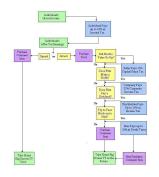Earlier today at the Friedman Conference in Australia, I spoke on the proper design of a tax system.
 My goal was to explain the problem of double taxation.
My goal was to explain the problem of double taxation.
I’ve repeatedly shared a flowchart to illustrate the pervasive double taxation in the current system (my example is for the United States, but many other nations make the same mistake).
And to help explain why this is economically misguided, I developed a (hopefully) compelling visual based on how to harvest apples.
But I’ve always wondered if I was presenting the information in an accessible and understandable manner. So for today’s presentation, I decided to experiment with some different visuals.
 Here’s how I illustrated the current system.
Here’s how I illustrated the current system.
As you can see, there are several additional layers of tax on people who save and invest their after-tax income.
And I explained to the crowd that this is very foolish since every economic theory agrees that saving and investment are key to long-run growth.
Even socialism. Even Marxism. (Socialists and Marxists are foolish to think government can be in charge of allocating capital, but at least they realize that future growth requires saving and investment.)
In other words, you don’t achieve good tax policy solely by having a low tax rate.
Yes, that’s important, but genuine tax reform also means no bias against saving and investment.
Here’s another visual. This one shows the difference between the current system and the flat tax. As you can see, all the added layers of tax on saving and investment are jettisoned under true tax reform.
By the way, there are some people who prefer a national sales tax over a flat tax.
I question the political viability of that approach, but I’ve always defended the sales tax.
Why? Because it’s conceptually identical to the flat tax.
As you can see from this next visual, the difference between the two systems is that the flat tax grabs a bit of money when income is earned and the sales tax grabs a bit of money when income is spent (either today or in the future).
Remember, the goal is to eliminate the bias against saving and investing.
To economists who specialize in public finance, this is known as shifting to a “consumption base” system.
But I’ve never liked that language. What really happens under true tax reform is that we tax income, but using the right definition.
 The current system, by contrast, is known as a “comprehensive income tax” with a “Haig-Simons” tax base. But that simply means a system that taxes some forms of income over and over again.
The current system, by contrast, is known as a “comprehensive income tax” with a “Haig-Simons” tax base. But that simply means a system that taxes some forms of income over and over again.
Time for one final point.
Some people like a value-added tax because it avoids the problem of double taxation.
That’s certainly true.
But this final visual shows that adding a VAT to the current system doesn’t solve the problem. All that happens is that politicians have a new source of revenue to expand the welfare state.
If a VAT was used to replace the current tax system, that might be a very worthwhile approach.
But that’s about as likely as me playing the outfield later this year for the New York Yankees.
P.S. The VAT visual is overly simplified and it sidesteps the logistical issue of whether politicians would go for a credit-invoice VAT or a subtraction-method VAT. But the visual is correct in terms of how a VAT would interact with the current system.
P.P.S. All you need to know about the VAT is that Reagan was against it and Nixon was for it.



